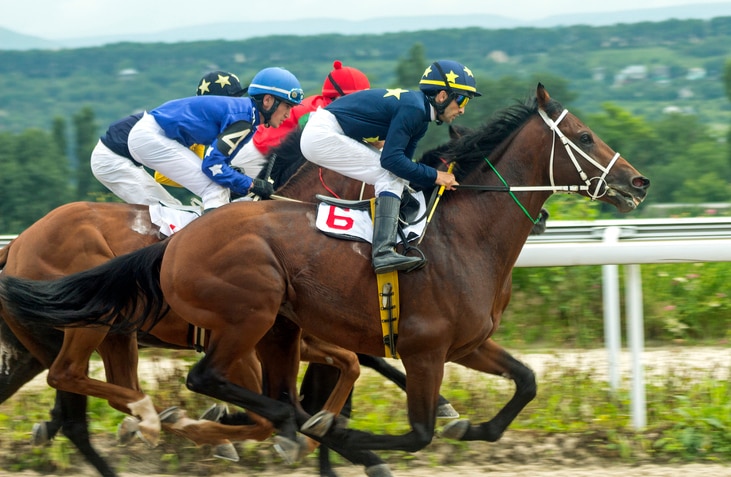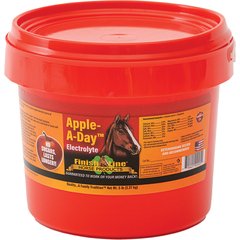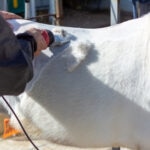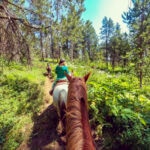From Ponies to Racehorses, How Fast Can Horses Run?

Photo by marlenka/iStock / Getty Images Plus via Getty Images
Whether galloping across open plains or sprinting around a racetrack against the clock, horses are among the fastest land mammals. As prey animals who rely on speed to escape predators in the wild, they have long been admired for their speed. But exactly how fast can a horse run?
The top speed of a horse depends on several factors, including breed, training, and environmental conditions. Let’s take a look at the average speeds of different types of horses, their top speeds, and the breeds known for their incredible velocity.
How Fast Can Horses Run on Average?
Horses generally have four gaits: walk, trot, canter, and gallop. The gallop is the fastest gait and is seen naturally in both racehorses ridden by jockeys and in horses at liberty.
The average canter or gallop speeds for different types of horses include:
- Ponies: 10–15 mph
- Small horses: 15–20 mph
- Large horses: 20–25 mph
- Racehorses: 35–40 mpg
Several factors contribute to a horse’s top speed:
- Breed: Some breeds, like the Thoroughbred and Quarter Horse, are bred specifically for speed. Generally speaking, “lighter” built breeds are faster than “heavier” breeds, such as cold-blooded draft horses, which are stronger but slower.
- Height and weight: Tying in to breed, lighter horses with longer legs tend to be faster. Those with a big stride and efficient gallop cover more ground with each step, meaning they reach the finish line faster.
- Stride: “Some of the main factors determining a horse’s speed are stride length and stride rate, two factors that are often tied to a horse’s body size,” explains Courtnee Morton, DVM, CVA, CVC, a veterinarian at Chewy and the owner of Southern Comfort Equine, based in Hico, Texas.
- Training and conditioning: Racehorses undergo rigorous training regimens to maximize their speed and endurance. Horses who go through strength and speed conditioning will have stronger muscles and better-conditioned lungs and cardiovascular systems, allowing them to get up to and maintain a faster pace.
- Health and nutrition: High-quality horse feed and proper hydration can play a part in how fast horses run.
Recommended Products
- Rider influence: Whether a rider speeds up or slows down a horse depends on their skill level, actions in the saddle, and body weight. “If a rider has poor symmetry, balance, or posture, not only are they creating extra weight for their horse to carry, [but] they can [also] negatively affect their gait and speed,” says Dr. Morton.
What Is the Top Horse Speed?
So how fast do horses run when they reach their peak performance?
“The top speed for a horse is typically recorded during racing events,” says Arianna Biondo, BS, assistant racing secretary at Penn National Race Course in Grantville, Pennsylvania.
“The fastest racehorses, ridden by jockeys, can surpass 50 mph in short bursts, though sustained racing speeds are lower,” she adds.
The fastest recorded speed of a horse was 55 mph, achieved by a Quarter Horse in a short sprint, typically a quarter mile (hence the name of the breed). Meanwhile, Thoroughbreds typically race at about 35 mph over longer distances, usually 1¼ miles.
Horses take only a few strides to reach full speed, utilizing their powerful hindquarters to push off and extend their strides. A horse can only maintain its top speed in short bursts; it only takes a few minutes or even seconds before fatigue sets in. Racehorses often need days to recover from a race, including rest and proper hydration.
“A fully galloping horse extends their front legs forward while propelling themselves with their hind legs,” explains Biondo. “The suspension phase, where all four hooves are off the ground, is crucial to maximizing speed. While horses can reach high speeds naturally, racehorses often require human intervention—training, diet, and optimal race conditions—to achieve record-breaking performances.”
What Is the Fastest Breed of Horse?
The American Quarter Horse is considered to be the fastest horse breed, known for its explosive speed in short sprints. These athletes excel in quarter-mile races, where they can reach speeds close to 50 mph despite generally being shorter and stockier than Thoroughbred racehorses.
Other fast horse breeds include:
- Thoroughbreds: The dominant breed in horse racing, reaching 40–45 mph at a gallop.
- Standardbreds: Used in harness racing, achieving 30–35 mph speeds while pulling a cart with a driver at the trot or a unique gait called pacing.
Who Was the Fastest Horse in the World?
One of the most famous racehorses in history, a Thoroughbred stallion named Secretariat, set a record in the 1973 Belmont Stakes, reaching a sustained speed of 37.8 mph over the race’s distance of 1.5 miles.
That being said, the title of the fastest horse in history is often attributed to Winning Brew, a Thoroughbred filly who set the Guinness World Record for the fastest speed recorded (43.97 mph) over two furlongs (a quarter mile) in 2008.
The Guinness World Records measure the fastest recorded speed over a specific distance in a controlled race setting, which is why Winning Brew (43.97 mph) holds the title. However, in unofficial settings, racing Quarter Horses like A Long Goodbye have reportedly reached speeds exceeding 55 mph over very short distances, holding up this incredible pace for just a few seconds.
FAQs About Horse Speed
How fast can a horse run with a rider?
A horse with a rider can reach impressive speeds for short distances, typically 30–40 mph for racehorses.
“A well-fed, conditioned, and trained horse running on a prepped surface will naturally have a higher peak speed than a non-conditioned horse in the wild that lives just on forage,” Dr. Morton says.
How fast can a horse run in the wild?
Wild horses, such as Mustangs, can reach speeds of 30–35 mph speeds when fleeing predators. However, due to energy conservation needs, they rarely sustain these speeds for long periods.
This content was medically reviewed by Kaela Schraer, DVM.





